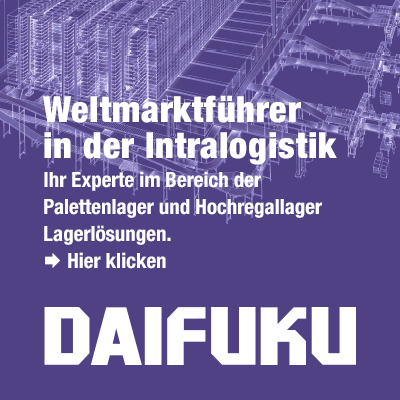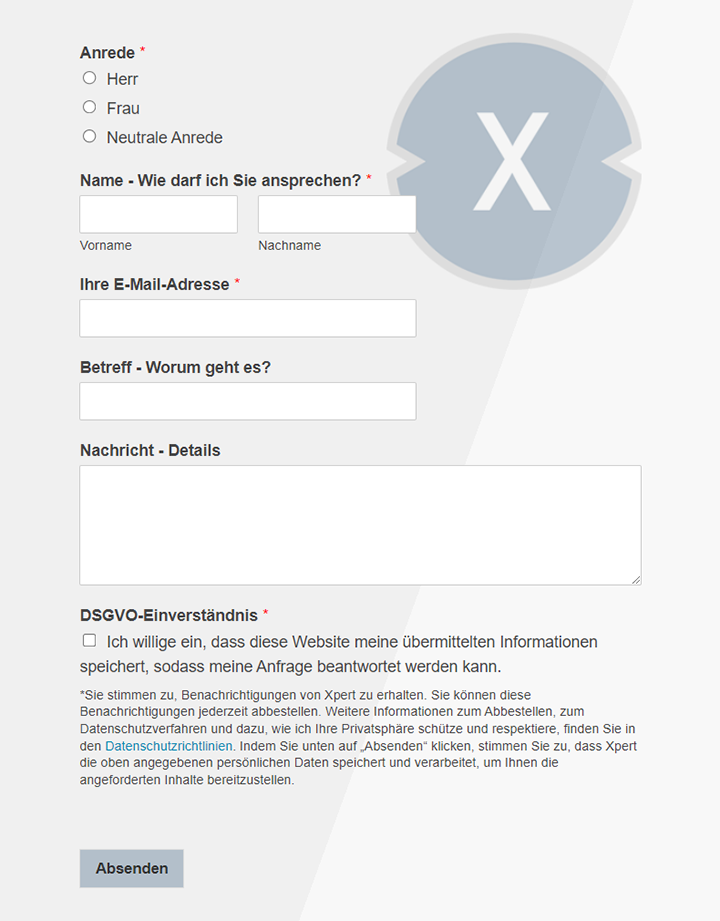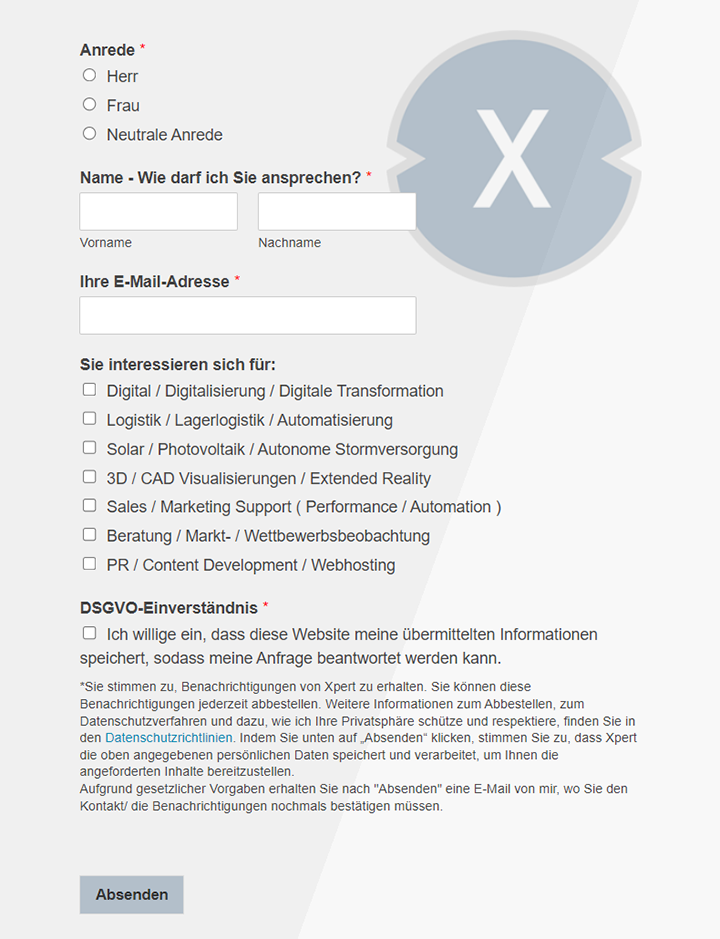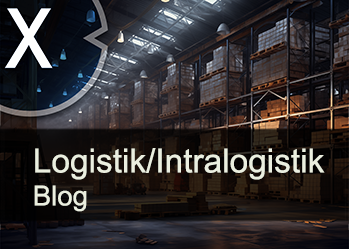Work-path logistics and efficient reusable management-the optimization of logistics processes and supply chains
Xpert pre-release
Language selection 📢
Published on: February 10, 2025 / update from: February 10, 2025 - Author: Konrad Wolfenstein

Work-path logistics and efficient reusable management-the optimization of logistics processes and supply chains
Sustainable supply chains: innovations for more efficiency and sustainability
Companies rely on smart solutions for more efficient supply chains
The optimization of logistics processes and supply chains is a crucial factor for companies to increase competitiveness, efficiency and sustainability. In view of the current developments and technological advances, more and more companies are relying on innovative solutions to improve their supply chains and to design them in a way that is resourceful.
Reusable logistics and efficient reusable management
Reusable systems play an increasingly important role, since they not only reduce environmental pollution, but also reduce costs and optimize processes. Companies are increasingly relying on digital solutions to manage these systems:
- The Nagel Group implements a software solution for digital real-time management of reusable objects such as pallets and Euroboxes at all 130 locations. This enables transparent tracking, optimizes coordination processes and relieves employees.
- Chelmer Foods has switched its pallet management to pooled reusable plastic pallets from Tosca, which reduces inefficiencies and at the same time ensures consistent quality and higher customer satisfaction.
Optimization of logistics networks
The structural optimization of logistics networks is a strategic measure to reduce transport costs and increase efficiency:
- The Radeberger Group moves its national pick -up ramp in the south of Bischofsheim to Nuremberg/Fürth to optimize flows of goods both ecologically and economically.
- The German drinks logistics (DGL) expand its capacities in northern Germany with new locations in Bremen and Hanover, which leads to shortened transport routes and increased efficiency.
Suitable for:
- GS1 DataMatrix Code: The Future of Product Identification and Global Supply Chains - Advances and Benefits for Various Industries
- Supply chain optimization: New logistics strategies due to the corona pandemic, including with digital twins
Smart supply chains in e-commerce
Digitization revolutionizes the e-commerce area through smart supply chains that rely on technologies such as big data, artificial intelligence (KI), Internet of Things (IoT) and robotics:
- Companies use digital supply chains to get detailed insights into the entire delivery process and make processes more efficient.
- Intelligent inventory management systems, automated warehouse solutions and advanced order management systems optimize processes and shorten delivery times.
Strategic approaches to optimize the supply chain
In order to make supply chains more efficient in the long term, several strategic approaches are of particular importance:
Data -driven decision -making process
The analysis and use of data helps companies to react flexibly to market changes:
- Predictive analytics enables more precise demand forecast and production planning.
- Real -time data improve the reactionability to changing market conditions.
Technology use and digitization
The use of modern technologies plays a key role in process optimization:
- Supply Chain Management (SCM) software automated routine tasks such as order processing and stock tracking.
- IoT devices and real-time tracking systems improve transparency along the supply chain.
Collaboration and partnerships
Closer cooperation with partners promotes efficiency and innovation:
- Strategic partnerships with suppliers optimize procurement processes.
- Common investments in innovative technologies increase competitiveness.
Flexibility and agility
Companies have to quickly adapt to changed conditions:
- Development of emergency plans for risk minimization.
- Flexible production and logistics processes reduce bottlenecks.
Lean Supply Chain Management
Lean principles contribute to increasing efficiency:
- Identification and reduction of waste.
- Optimization of stocks through just-in-time practices.
Sustainability and risk management
Sustainable supply chains are crucial for the future:
- Integration of environmentally friendly technologies in transport and warehousing.
- Automated tools for risk detection and avoidance.
Process optimization for more efficiency and agility
Efficiency and agility can be increased by different methods:
Structured process analysis
A detailed analysis of existing processes is essential:
- Identification of bottlenecks and inefficiencies.
- Use of lean management, Six Sigma and Business Process Reengineering.
Use of technology and automation
- Automation reduces manual errors and increases efficiency.
- Cloud computing and AI improve the scalability of processes.
Agile methods and corporate culture
- Agile working methods promote adaptability and innovation.
- Employee participation strengthens commitment and improves decision -making.
Continuous monitoring and improvement
- KPIS help to measure the performance and uncover optimization potential.
- Regular evaluations enable quick adjustments to market changes.
Integration of efficiency and agility
The combination of standardized processes and flexibility is crucial:
- Optimized processes enable a quick reaction to market changes.
- Agil implemented methods increase efficiency and speed.
Proven methods for process optimization
Lean Six Sigma
The combination of lean management and Six Sigma optimizes processes through:
- Reduction of waste.
- Minimization of errors by data -based analyzes.
Kaizen (continuous improvement)
- Small, continuous improvements ensure sustainable optimization.
- Employees commitment at all levels are funded.
Suitable for:
Agile methods
- Methods such as Scrum and Kanban increase transparency and efficiency.
- Faster responsiveness to market changes.
Suitable for:
Digital process optimization
- Process management software improves documentation and automation.
- Process Mining enables data -based insights into real process processes.
Business Process Reengineering (BPR)
- Radical restructuring increases efficiency significantly.
- Often requires larger strategic adjustments.
The choice of the right methods depends on the individual corporate structure and the strategic goals. The combination of different approaches often leads to the best results. Through targeted process optimization, efficiency, cost savings and competitiveness can be ensured in the long term.
Xpert partner in warehouse planning and construction
Optimization of logistics processes and supply chains: a comprehensive overview - background ductse
Lief chains 4.0: How companies strategically revolutionize their logistics
In today's dynamic and globalized economic world, the optimization of logistics processes and supply chains is no longer just an operational necessity, but rather a decisive strategic competitive advantage. Companies that make their supply chains efficiently are better positioned to react to market fluctuations, reduce costs, increase customer satisfaction and ultimately consolidate or expand their market position. The latest developments in the industry underline the relevance of this topic and show that innovation and increase in efficiency are still in focus in logistics.
Reusable logistics and intelligent reusable management
An area that has become increasingly important in recent years is reusable logistics. Companies are increasingly recognizing the ecological and economic advantages of reusable systems and investing in their optimization. The Nagel Group, for example, recognized this trend and implemented a comprehensive software solution from the logistics booth. This solution enables digital real -time management of reusable objects such as pallets and Euroboxes across all 130 locations. This implementation creates continuous transparency in the reusable cycles. The locations can see in real time, where there are reusable objects, which quantities are available and when returns or subsequent deliveries are required. This not only optimizes the coordination processes between the locations, but also relieves the employees of time -consuming manual processes, which are traditionally connected to the management of reusable objects. The improved transparency and efficiency leads to a reduction in losses, empty trips and unnecessary storage costs, which has a positive effect on the total costs and the environmental balance of the company.
Chelmer Foods also took an important step towards optimized reusable management by switching its pallet management to pooled reusable plastic pallets from Tosca. The transition from disposable or less standardized pallet systems to pooled reusable plastic pallets offers a number of advantages. Inefficiencies that arise from damaged pallets, different quality standards and elaborate sorting processes are minimized. Pooled systems guarantee a constant quality of the pallets, which increases safety in the warehouse and during transport and reduces the risk of product damage. In addition, the availability of high -quality pallets improves customer satisfaction, since smooth and efficient delivery processes are guaranteed. The use of plastic pallets in reusable systems also contributes to sustainability, since they have a longer lifespan compared to wooden pallets and can be recycled at the end of their life cycle.
Optimization of logistics networks for improved flow of goods
The strategic optimization of logistics networks is another important lever to increase efficiency in the supply chain. Large companies continuously analyze their flows of goods and locations to adapt their networks to changed market conditions and customer requirements. The Radeberger Group, an important company in the beverage industry, optimizes, for example, its national logistics network by moving its central pick -up ramp in the south. The move from Bischofsheim to Nuremberg/Fürth, planned for the turn of the year 2025/26, is a strategic step to optimize the flows of goods ecologically and economically. By moving to a more central location with a better transport connection and proximity to important sales markets, pick-up and delivery kilometers can be reduced. This not only leads to lower transport costs and a reduction in CO2 emissions, but also to faster throughput times and improved delivery reliability. Such network optimizations are complex projects that require a detailed analysis of the flow of goods, transport costs, storage capacity and the geographical distribution of customers and suppliers. However, the potential benefit in terms of cost reduction and increase in efficiency is significant.
The German beverage logistics (DGL), a joint venture, also invested in the expansion of its logistics capacities in northern Germany. The opening of new locations in Bremen and Hanover is a reaction to the growing business volume and the need for nationwide and efficient beverage logistics in this region. Due to the decentralized warehousing and proximity to customers, transport routes can be shortened and delivery times can be reduced. The new locations enable the DGL to react more flexibly to regional demand fluctuations and to offer an even better service for your customers. Network expansions such as this are a sign of growth and the increasing importance of the logistics industry, especially in the area of beverage logistics, where seasonal fluctuations and regional peculiarities require high flexibility and adaptability.
Suitable for:
Smart Supply Chains in E-Commerce: Digitization as a driver of efficiency
The e-commerce sector is another area in which optimization of the supply chain plays a crucial role. The rapid growth of online trading has led to ever higher requirements for speed, flexibility and transparency in the supply chains. Smart, digitized supply chains are the key to meet these requirements and to be successful in competition. These intelligent supply chains use a variety of modern technologies, including big data analytics, artificial intelligence (AI), the Internet of Things (IoT) and robotics. By using these technologies, data can be automatically processed, processes can be optimized in real time and logistical efficiency is significantly increased.
Digital supply chains offer a detailed insight into every step of the delivery process, from ordering to warehousing and transport to delivery at the end customer. This transparency enables companies to recognize bottlenecks and inefficiencies at an early stage and to initiate specific measures to improve. By analyzing real -time data, for example, routes can be optimized, stocks can be controlled precisely and delivery times shortened. This not only leads to efficiency increases and cost reductions, but also to improved resource use and higher customer satisfaction. In the e-commerce sector, companies are increasingly relying on intelligent inventory management systems that use AI and Predictive Analytics to predict demand and automatically adjust inventory. Automated warehouse solutions, such as robot and picking systems, accelerate order processing and reduce errors. Advanced order management systems ensure smooth and transparent order processing and enable customers to pursue the status of their orders in real time.
These developments in various areas of logistics and supply chain management illustrate that companies are continuously looking for innovative solutions to optimize their processes, reduce costs and increase efficiency. Digitization plays a central role in this and enables companies to make their supply chains of intelligent, more flexible and more resistant.
Strategic approaches for effective supply chains Optimization
In order to effectively optimize a supply chain, a holistic and strategic approach is required. It is not enough to look at individual processes in isolation. Rather, it is necessary to understand and optimize the entire supply chain as a coherent system. Various strategic approaches play a crucial role.
Data -driven decision -making: The basis for agility
In today's fast -moving business world, well -founded decision -based decision -making is essential in order to be able to react flexibly to market trends and changes in customer behavior. Companies must be able to collect large amounts of data, analyze and gain valuable knowledge from them. The continuous analysis of data makes it possible to anticipate changes in consumer behavior at an early stage and proactively take measures. Predictive analytics, an area of data analysis that deals with the prediction of future events, plays an increasingly important role. By using predictive analytics, companies can precisely predict the demand and adapt their production plans, inventory and transport capacities accordingly. Real-time data, which are recorded, for example, by IoT devices and tracking systems, enable companies to react to changes in the supply chain in real time. For example, if a transport vehicle gets into a traffic jam, the system can automatically calculate alternative routes and proactively inform the customer about the delay. Data -driven decision making is the basis for an agile and reactionable supply chain.
Technology use and digitization: The key to increasing efficiency
The use of modern technologies and digitization play a key role in optimizing supply chains. The implementation of Supply Chain Management (SCM) Software is an essential step to automate routine tasks and to improve efficiency. SCM systems enable companies to automate and centralize order processing, inventory, transport planning and many other processes. Cloud solutions offer additional advantages in terms of scalability and flexibility. Companies can flexibly adapt their IT infrastructure to their needs and access their data and applications from anywhere. The Internet of Things (IoT) and real-time tracking systems ensure improved transparency in the entire supply chain. IoT sensors that are attached to products, pallets or transport vehicles continuously provide data about the location, condition and environmental parameters. This data can be used to monitor supply chains in real time, recognize bottlenecks, optimize route planning and increase security. The combination of various technologies and digital solutions enables companies to fundamentally transform their supply chains and achieve a new level of efficiency and agility.
Collaboration and partnerships: Together to success
Close cooperation with suppliers and partners is indispensable for successful supply chain optimization. The supply chain is a network of companies that are closely connected and are dependent on each other. The structure of strategic partnerships with key suppliers is therefore of great importance. Through close cooperation, companies can exchange information, coordinate processes and promote innovations together. Common investments in innovations and process automation can increase the efficiency of the entire supply chain. Collaborative Planning, Forecasting and Replenishment (CPFR) is a proven approach to cooperation in the supply chain. CPFR includes the joint planning, forecast and inventory filling between manufacturers and dealers. By exchanging information and the coordination of forecasts, companies can optimize their stocks, avoid incorrect stocks and improve delivery reliability. Collaboration and partnerships are therefore an important success factor for efficient and resilient supply chain.
Flexibility and agility: adaptability in a volatile world
The ability to quickly adapt to changed conditions is of crucial importance in today's volatile and insecure world. Companies must be able to react to unforeseen events such as natural disasters, political crises or sudden changes in demand. The development of contingency plans for potential disorders is an important part of risk management. Contingence plans determine which measures must be taken in the event of a disturbance in order to minimize the effects on the supply chain. The implementation of flexible production and logistics processes enables companies to react quickly to changes in demand and to adapt their production capacities and transport routes. The structure of a diversified supplier network contributes to risk minimization. If a supplier fails, companies can fall back on alternative suppliers and maintain delivery continuity. Flexibility and agility are therefore decisive factors for the resilience and competitiveness of supply chains.
Lean supply chain management: eliminate waste, create value
The use of lean principles can significantly increase the efficiency of supply chains. Lean Management focuses on the identification and elimination of waste in processes. Waste can occur in different forms, for example in the form of unnecessary transport routes, stocks, waiting times or errors. By analyzing processes and the identification of sources of waste, companies can optimize their processes and increase productivity. The optimization of inventory by just-in-time practices is an important aspect of Lean Supply Chain Management. Just-in-time means that materials and products are delivered exactly when they are needed, which minimizes inventory and stores storage costs. The continuous improvement of processes, also known as Kaizen, is another important principle of lean management. Kaizen includes the constant search for potential for improvement and the implementation of small, incremental improvements. Lean Supply Chain Management aims to slim down processes, eliminate waste and maximize the added value.
Sustainability and risk management: take responsibility, minimize risks
Sustainability and risk management are increasingly important aspects of the supply chain optimization. Consumers and companies are increasing greater importance to sustainability and expect products and services to be produced and delivered in an environmentally friendly and socially responsible manner. The integration of sustainability practices into the entire supply chain is therefore essential. This includes, for example, reducing CO2 emissions, using environmentally friendly materials, avoiding waste and compliance with social standards in suppliers. Proactive risk management is also of great importance for maintaining delivery continuity. Automated risk detection tools can support companies in identifying and evaluating potential risks in the supply chain at an early stage. The development of strategies for risk reduction, such as the diversification of suppliers or the implementation of emergency plans, is crucial to minimize the effects of disorders and to ensure delivery continuity. Sustainability and risk management are not only ethical obligations, but also important factors for the long -term success and competitiveness of companies.
By implementing these strategic approaches, companies can comprehensively optimize their supply chains, reduce costs, increase efficiency, ensure their competitiveness in the long term and at the same time meet their social and ecological responsibility.
Adaptation of processes for flexibility and efficiency
In order to be successful in a dynamic market environment, companies must continuously adapt their processes in order to increase both flexibility and efficiency. A balanced balance between these two goals is crucial for long -term success.
Structured process analysis and optimization: Recognize vulnerabilities, raise potential
A thorough analysis of the existing processes is the first and most important step towards improving the process. Companies have to identify and document their current processes in detail in order to uncover weaknesses and bottlenecks. Process mapping and value novelalyzes are proven methods to visually present processes and identify inefficiencies. After the analysis, clear, measurable goals for process optimization must be defined. These goals can include, for example, reducing throughput times, reduction in costs, improving the quality or increasing customer satisfaction. Various proven methods are available for the redesign of processes, such as lean management, Six Sigma or Business Process Reengineering. Lean Management focuses on the elimination of waste, Six Sigma on reducing errors and business process reengineering on the radical redesign of processes. The choice of the appropriate method depends on the specific goals and the scope of the desired process improvement.
Use of technology and automation: Efficiency through innovation
Modern technologies play a crucial role in increasing the efficiency and flexibility of processes. The implementation of software solutions for automation of routine tasks is an essential step towards increasing efficiency. Robotic Process Automation (RPA) enables companies to automate repetitive and rule -based tasks and to relieve employees of these activities. Cloud computing offers flexible and scalable IT infrastructures that enable companies to adapt their IT resources as required. Artificial intelligence (AI) and Machine Learning (ML) open up new opportunities for process optimization. AI-based systems can analyze large amounts of data, recognize patterns, create forecasts and automate decisions. The Internet of Things (IoT) enables the networking of devices and systems and provides real -time data for process monitoring and control. Digital platforms improve internal communication and project coordination. Collaboration tools and project management software facilitate the cooperation of teams, improve the flow of information and accelerate decision-making processes. The targeted use of technology and automation can significantly increase the efficiency of processes and at the same time increase flexibility.
Agile methods and corporate culture: promote adaptability
An agile corporate culture and the introduction of agile methods are crucial to increase the flexibility and responsiveness of companies. Agile methods, such as Scrum or Kanban, make it possible to react faster to market changes and to develop innovative products and services. Agile methods are characterized by iterative and incremental ways of working, short feedback cycles and high adaptability. An agile corporate culture promotes continuous learning and innovation. Employees are encouraged to bring in new ideas, to experiment and learn from mistakes. The involvement of employees in decision -making processes strengthens commitment and promotes adaptability. Self -organized teams, flat hierarchies and open communication channels are typical features of an agile corporate culture. The combination of agile methods and an agile corporate culture enables companies to become more flexible, more innovative and customer -oriented.
Continuous monitoring and improvement: optimize processes dynamically
Process optimization is not a unique project, but an ongoing process. Companies must continuously monitor and improve their processes in order to be successful in the long term. The implementation of key performance indicator (KPIS) is essential to make the process performance measurable and pursue progress. KPIs should be relevant, measurable, accessible, relevant and time -tied (smart). Regular evaluations and performance reviews enable companies to react quickly to changes and to initiate corrective measures. Collecting feedback from employees and customers is valuable to identify potential for improvement and continuously optimize the processes. Feedback can be obtained through surveys, interviews, workshops or informal conversations. The continuous monitoring and improvement of processes based on data and feedback is the key to a dynamic and learning organization.
Integration of efficiency and agility: find the optimal balance
The successful adaptation of processes requires the integration of efficiency and agility. Companies have to optimize processes in order to use resources efficiently and reduce costs, but at the same time be flexible enough to be able to react quickly to market changes. Agile methods should be implemented based on efficient processes in order to increase working speed and effectiveness. A balance between standardized processes and the ability to react flexibly to new requirements is crucial. Standardized processes ensure efficiency and consistency, while flexibility and agility enable adaptability to changed conditions. The art is to find the right balance between these two poles and to design processes in such a way that they are both efficient and flexible.
By implementing these strategies, companies can adapt their processes to become both more efficient and more flexible. This leads to improved competitiveness, higher customer satisfaction and the ability to react quickly to market changes and to successfully position yourself in a dynamic market environment.
Effective methods for process optimization: an overview
Based on current trends and knowledge in process optimization, some particularly effective methods crystallize that companies can successfully use in order to optimize their processes and to increase their efficiency sustainably.
Lean Six Sigma: The combination of strengths
Lean Six Sigma is a combination of lean management and Six Sigma and is considered a particularly effective method for process optimization. Lean Management focuses on eliminating waste in processes and increasing added value. The aim is to slim down processes, to shorten throughput times and reduce costs. Six Sigma, on the other hand, uses data -based analyzes for reducing errors and improvement in quality. The aim is to reduce process variability and maximize process quality. The connection between the two approaches enables companies not only to slim down processes, but also to optimize the quality and minimize errors. Lean Six Sigma Projects usually follow the DMAIC cycle (Define, Measure, Analyze, Improve, Control), a structured approach to problem solving and process improvement. Lean Six Sigma is particularly effective in complex processes with high susceptibility to errors and great potential for improvement.
Continuous improvement (Kaizen): gradually to success
Kaizen is a proven Japanese method that relies on small, constant improvements. The focus is on continuous learning and gradual optimization. Kaizen promotes the commitment of employees at all levels. Employees are encouraged to contribute to improvement and actively participate in the process improvement. Kaizen workshops and teams are typical instruments for the implementation of Kaizen principles. Kaizen is particularly effective for sustainable, long -term process improvement, since it is based on the principle of continuous development and the commitment of the employees. Small, incremental improvements that are continuously implemented can lead to significant increases in efficiency over time.
Agile methods: flexibility and quick adjustment
Agile approaches are becoming increasingly important in process optimization, especially in dynamic and complex environments. Agile methods enable greater flexibility and faster adaptation to changes. Methods such as Scrum or Kanban promote transparency and efficiency in projects and processes. Scrum is an iterative and incremental framework for project management, which is based on short sprints, regular meetings and a high self -organization of the teams. Kanban is a visual system for controlling the workflow based on the limitation of the work-in-progress (WIP) and the continuous improvement of the flow. Agile methods are particularly suitable for projects and processes that are characterized by high complexity, uncertainty and frequent changes.
Digital process optimization: technology as an enabler
As technology progresses, digital tools are becoming increasingly important for process optimization. Process management software supports companies in modeling, documentation and automation of processes. Business Process Management Systems (BPMS) enable the digital mapping of business processes, the automation of tasks and monitoring process performance. Process Mining enables data -based insights into real process processes. By analyzing event protocols, companies can recognize bottlenecks, inefficiencies and deviations in their processes. AI-based analysis tools help identify optimization potential and the automation of decisions. Digital process optimization uses the possibilities of technology to make processes more efficient, transparent and more resistant.
Suitable for:
Business Process Reengineering (BPR): Radical redesign
Business Process Reengineering (BPR) is an effective method for basic restructuring and radical process improvements. BPR enables the radical redesign of processes by fundamentally questioning existing processes and being redesigned from scratch. The aim is to simplify, accelerate and make processes more efficient. BPR can lead to significant increases in performance, but often requires major changes in the organization and work processes. BPR is particularly suitable for companies that have inefficient or outdated processes and strive for fundamental change.
The choice of the most effective method for process optimization depends heavily on the specific context, the goals, corporate culture and the available resources. A combination of different approaches is often the most effective in order to optimize processes holistically and to increase efficiency sustainably. Companies should carefully check the various methods and select and combine the most suitable approaches for their specific needs and goals.
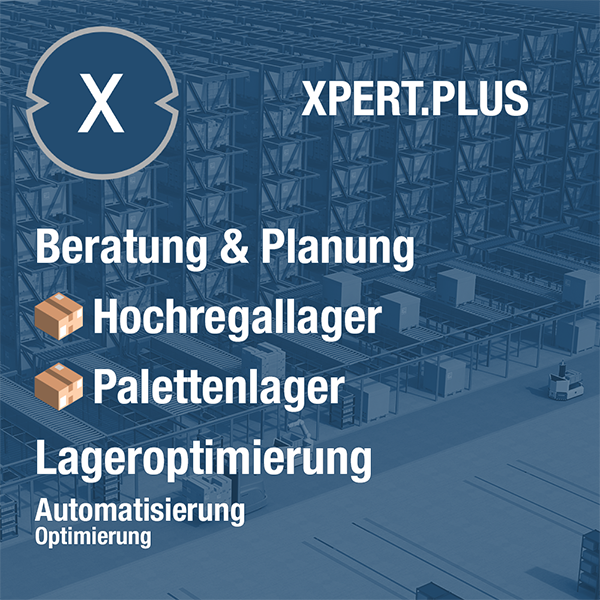
Xpert.Plus warehouse optimization - high-bay warehouses such as pallet warehouses consulting and planning
We are there for you - advice - planning - implementation - project management
☑️ SME support in strategy, consulting, planning and implementation
☑️ Creation or realignment of the digital strategy and digitalization
☑️ Expansion and optimization of international sales processes
☑️ Global & Digital B2B trading platforms
☑️ Pioneer Business Development
I would be happy to serve as your personal advisor.
You can contact me by filling out the contact form below or simply call me on +49 89 89 674 804 (Munich) .
I'm looking forward to our joint project.
Xpert.Digital - Konrad Wolfenstein
Xpert.Digital is a hub for industry with a focus on digitalization, mechanical engineering, logistics/intralogistics and photovoltaics.
With our 360° business development solution, we support well-known companies from new business to after sales.
Market intelligence, smarketing, marketing automation, content development, PR, mail campaigns, personalized social media and lead nurturing are part of our digital tools.
You can find out more at: www.xpert.digital - www.xpert.solar - www.xpert.plus



